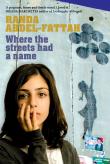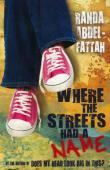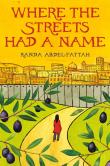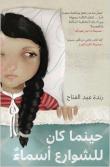AustLit
Latest Issues
AbstractHistoryArchive Description
'Thirteen-year-old Hayaat is on a mission. She believes a handful of soil from her grandmother's ancestral home in Jerusalem will save her beloved Sitti Zeynab's life. The only problem is the impenetrable wall that divides the West Bank, as well as the check points, the curfews, the permit system and Hayaat's best friend Samy, who is mainly interested in football and the latest elimination on X-Factor, but always manages to attract trouble.
'But luck is on their side. Hayaat and Samy have a curfew-free day to travel to Jerusalem. However, while their journey may only be a few kilometres long, it may take a lifetime to complete.' (Publisher's blurb)
Adaptations
-
y
 Where the Streets Had a Name
2017
Strawberry Hills
:
Currency Press
,
2018
12643353
2017
single work
drama
Where the Streets Had a Name
2017
Strawberry Hills
:
Currency Press
,
2018
12643353
2017
single work
drama
'Hayaat is on a mission. She will even skip school to achieve it (encouraged by her best friend Samy). She is determined to retrieve a handful of soil from her Grandmother’s farm as this will make her beloved Sitti Zeynab well again. Standing between her and her goal is the impenetrable wall that divides the West Bank.
'With themes of displacement, family, freedom and friendship, this is a powerful story of one family’s response to the confinements of curfew and how they rise above, with humour and love.'
Source: Monkey Baa
Notes
-
Dedication: To my grandmother Sitti Jamilah, who passed away on 24th April 2008, aged 98. I had hoped that you would live to see this book and that you would be allowed to touch the soil of your homeland again. It is my consolation that you died surrounded by my father and family and friends who cherished you. May you rest in peace.
And to my father — may you see a free Palestine in your lifetime.
Affiliation Notes
-
This work is affiliated with the AustLit subset Asian-Australian Children's Literature and Publishing because it is set in the Middle East.
Publication Details of Only Known VersionEarliest 2 Known Versions of
Other Formats
- Sound recording.
Works about this Work
-
A Handful of Soil: An Ecocritical Reading of Land in Randa Abdel-Fattah’s Where the Streets Had a Name
2014
single work
criticism
— Appears in: Asiatic , December vol. 8 no. 2 2014; (p. 137-148) 'This article explores how Randa Abdel-Fattah (1979-), a Palestinian-Egyptian Australian diasporic writer, engages with the land as being ecocritically functional in her Palestinian-centred novel Where the Streets Had a Name (2008). The premise of the article is that a fictional representation of the Palestinian struggle for emancipation against occupation can be read for its environmental concerns; in particular, for the representation of the intersections of nature and culture. To this end, the article proposes a tripartite approach in reading politics of environment in the narrative by focusing on the effects of land on mind, body and voice. The analysis is carried out through the lens of ecocriticism and it reveals the symbiotic interconnections between humans and land. The findings reveal that the crisis experienced by the Palestinians in Abdel-Fattah‟s fiction goes beyond the need to preserve their past as the land has strong implications on their present state of mind, body and voice.' (Publication abstract) -
Reading and Viewing : Mapping Different Worlds
2010
single work
review
— Appears in: English in Australia , vol. 45 no. 1 2010; (p. 62-63)
— Review of Where the Streets Had a Name 2008 single work children's fiction -
Aussie YA Published in Arabic
2010
single work
column
— Appears in: Bookseller + Publisher Magazine , July vol. 89 no. 9 2010; (p. 11) -
Untitled
2009
single work
review
— Appears in: Fiction Focus : New Titles for Teenagers , vol. 23 no. 2 2009; (p. 11-12)
— Review of Where the Streets Had a Name 2008 single work children's fiction -
Untitled
2009
single work
review
— Appears in: Reading Time : The Journal of The Children's Book Council of Australia , February vol. 53 no. 1 2009; (p. 29)
— Review of Where the Streets Had a Name 2008 single work children's fiction
-
Untitled
2008
single work
review
— Appears in: Bookseller + Publisher Magazine , September vol. 88 no. 3 2008; (p. 39)
— Review of Where the Streets Had a Name 2008 single work children's fiction -
On the Road : The Tale of Two Sittis
2008
single work
review
— Appears in: The Age , 15 November 2008; (p. 22)
— Review of Finnikin of the Rock 2008 single work novel ; Where the Streets Had a Name 2008 single work children's fiction -
Find It or Flee from It, You Can't Ignore Truth
2008
single work
review
— Appears in: The Sydney Morning Herald , 29-30 November 2008; (p. 37)
— Review of Give Me Truth 2008 single work novel ; Hunting Elephants 2008 single work novel ; Where the Streets Had a Name 2008 single work children's fiction -
Cracks Still Show
2008
single work
review
— Appears in: Australian Book Review , December no. 307 2008; (p. 67)
— Review of Where the Streets Had a Name 2008 single work children's fiction -
[Untitled]
2008
single work
review
— Appears in: Magpies : Talking About Books for Children , November vol. 23 no. 5 2008; (p. 39)
— Review of Where the Streets Had a Name 2008 single work children's fiction -
Aussie YA Published in Arabic
2010
single work
column
— Appears in: Bookseller + Publisher Magazine , July vol. 89 no. 9 2010; (p. 11) -
A Handful of Soil: An Ecocritical Reading of Land in Randa Abdel-Fattah’s Where the Streets Had a Name
2014
single work
criticism
— Appears in: Asiatic , December vol. 8 no. 2 2014; (p. 137-148) 'This article explores how Randa Abdel-Fattah (1979-), a Palestinian-Egyptian Australian diasporic writer, engages with the land as being ecocritically functional in her Palestinian-centred novel Where the Streets Had a Name (2008). The premise of the article is that a fictional representation of the Palestinian struggle for emancipation against occupation can be read for its environmental concerns; in particular, for the representation of the intersections of nature and culture. To this end, the article proposes a tripartite approach in reading politics of environment in the narrative by focusing on the effects of land on mind, body and voice. The analysis is carried out through the lens of ecocriticism and it reveals the symbiotic interconnections between humans and land. The findings reveal that the crisis experienced by the Palestinians in Abdel-Fattah‟s fiction goes beyond the need to preserve their past as the land has strong implications on their present state of mind, body and voice.' (Publication abstract)
Awards
- 2010 shortlisted Festival Awards for Literature (SA) — Children's Literature Award
- 2009 winner Inky Awards — Gold Inky
-
Jerusalem,
cIsrael,cMiddle East, Asia,
- Palestine, Middle East, Asia,








